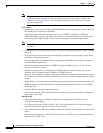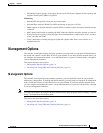
1-10
Catalyst 2940 Switch Software Configuration Guide
78-15507-02
Chapter 1 Overview
Network Configuration Examples
The workgroups are created by clustering all the Catalyst switches except the Catalyst 4500 switch.
Using CMS and Cisco switch clustering technology, you can group the switches into multiple clusters,
as shown, or into a single cluster. You can manage a cluster through the IP address of its active and
standby command switches, regardless of the geographic location of the cluster members.
Workgroups that require fiber connectivity can be connected to the network by the 2940-8TF-S with its
fixed 100-FX uplink. Multiple 100-FX links can be aggregated to a 3550-24FX or Catalyst 4500. As an
alternative, a Catalyst 2940-8TF with a 1000Base-SX SFP can be used to provide Gigabit connectivity
to a Catalyst 3550-12G or Catalyst 4500.
This network uses VLANs to segment the network logically into well-defined broadcast groups and for
security management. You can configure up to four VLANs on the Catalyst 2940 switch. Data and
multimedia traffic are configured on the same VLAN. Voice traffic from the Cisco IP Phones are
configured on separate voice VLAN IDs (VVIDs), or you can combine voice, multimedia, and data on
a single VLAN. For any switch port connected to Cisco IP Phones, 802.1P/Q QoS gives forwarding
priority to voice traffic over data traffic.
Grouping servers in a centralized location provides benefits such as security and easier maintenance.
The Gigabit connections to a server farm provide the workgroups full access to the network resources
(such as a call-processing server running Cisco CallManager software, a DHCP server, or an IP/TV
multicast server).
Cisco IP Phones are connected—using standard straight-through, twisted-pair cable with
RJ-45 connectors—to the 10/100 inline-power ports on the Catalyst 4500 switches and to the
10/100 ports on the Catalyst 2940 switches. These multiservice switch ports automatically detect any IP
phones that are connected. Cisco CallManager controls call processing, routing, and IP phone features
and configuration. Users with workstations running Cisco SoftPhone software can place, receive, and
control calls from their PCs. Using Cisco IP Phones, Cisco CallManager software, and Cisco SoftPhone
software integrates telephony and IP networks, and the IP network supports both voice and data.
Each 10/100 inline-power port on the Catalyst 4500 switches provides –48 VDC power to the Cisco IP
Phone. The IP phone can receive redundant power when it is also connected to an AC power source.
IP phones not connected to an inline power switch receive power from an AC power source.
Large Campus Configuration
Figure 1-3 shows a configuration for a network of more than 1000 users. Because it can aggregate up to
142 nonblocking Gigabit connections, a Catalyst 6500 multilayer switch is used as the distribution layer
switch.
You can use the workgroup configurations shown in previous examples to create workgroups with
Gigabit uplinks to the Catalyst 6500 switch. For example, you can use switch clusters that have a mix
of Catalyst 3550 and 2950 switches. Catalyst 2940 switches are used outside of the wiring closet in the
user environment to add managed ports if pulling additional wiring from the wiring closet is unfeasible
or not cost efficient.
The Catalyst 6500 switch provides the workgroups with Gigabit access to core resources:
• Cisco 7000 series router for access to the WAN and the Internet.
• Server farm that includes a call-processing server running Cisco CallManager software. Cisco
CallManager controls call processing, routing, and IP phone features and configuration.
• Cisco Access gateway (such as Cisco Access Digital Trunk Gateway or Cisco Access Analog Trunk
Gateway) that connects the IP network to the Public Switched Telephone Network (PSTN) or to
users in an IP telephony network.


















